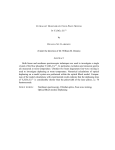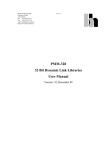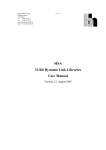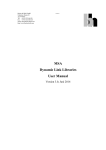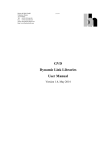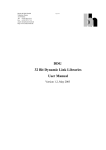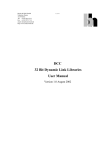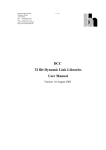Download LIA-150 32 Bit Dynamic Link Libraries User Manual
Transcript
Becker & Hickl GmbH Nahmitzer Damm 30 12277 Berlin Tel. +49 30 787 56 32 Fax. +49 30 787 57 34 email: [email protected] http://www.becker-hickl.de liadll32.doc LIA-150 32 Bit Dynamic Link Libraries User Manual Version 1.2 Dec. 99 Introduction The LIA 32 bits Dynamic Link Library contains all functions to control the LIA-150 modules. The functions work under Windows 95 and Windows NT. The program which calls the DLLs must be compiled with the compiler option 'Structure Alignment' set to '1 Byte'. The distribution disks contain the following files: LIADLL32.DLL dynamic link library main file LIADLL32.LIB import library file for Microsoft Visual C/C++, Borland C/C++, Watcom C/C++ and Symantec C/C++ compilers LIA_DEF.H Include file containing Types definitions, Functions Prototypes and Pre-processor statements LIA150.INI LIA DLL initialisation file LIADLL32.DOC This description file LIADLL32.TXT This description saved as a text file USE_LIA.XXX Set of files to compile and run a simple example of using the LIA DLL functions. The source file of the example is the file use_lia.c. The example was originally prepared under Borland C/C++, V.4.52. For use with other compilers, please choose the correct import library file to link. There is no special installation procedure required. Simply execute the setup program from the 1st distribution diskette and follow its instructions. LIA-DLL Functions list The following functions are implemented in the LIA-DLL: Initialisation functions: LIA_init LIA_get_id LIA_test_id LIA_test_if_active LIA_get_init_status LIA_set_simul LIA_get_mode Setup functions: LIA_get_parameters LIA_set_hard_parameters LIA_set_range LIA_get_range LIA_set_lfilter LIA_get_lfilter LIA_set_hfilter LIA_get_hfilter LIA_set_dyn_reserve LIA_get_dyn_reserve 2 LIA_set_phase_mode LIA_get_phase_mode LIA_set_ref_source LIA_get_ref_source LIA_set_ref_threshold LIA_get_ref_threshold LIA_get_ref_freq LIA_get_ref_freq_range LIA_set_harmonic LIA_get_harmonic LIA_set_trig_mode LIA_get_trig_mode LIA_set_out_filter LIA_get_out_filter LIA_set_out_rate LIA_get_out_rate LIA_set_offset LIA_get_offset LIA_set_dac LIA_get_dac LIA_get_eeprom_data LIA_write_eeprom_data LIA_get_adjust_parameters LIA_set_adjust_parameters Measurement control functions: LIA_start_measure LIA_stop_measure LIA_read_sample Status functions: LIA_test_if_sample_ready LIA_get_status Application Guide Initialisation of the LIA Measurement Parameters Before a measurement is started the measurement parameter values must be written into the internal structures of the DLL functions (not directly visible from the user program) and sent to the control registers of the LIA module. This is accomplished by the function LIA_init. The LIA DLL Functions can control up to four LIA modules. The LIA_init function - reads the parameter values from a specified file - checks the base I/O addresses for all active modules to avoid hardware conflicts - checks and recalculates the parameters depending on hardware restrictions and the adjust parameters from the EEPROM on each active LIA module - sends the parameter values to the LIA control registers of each active LIA module - performs a hardware test of each active LIA module 3 The initialisation file is an ASCII file with a structure shown in the table below. Each module has its own section in the initialisation file ([lia_module0..3]). Only modules which have an entry ‘ active = 1’ are initialised. We recommend either to use the file lia150.ini for initialisation or to start with lia150.ini and to introduce the desired changes. ; LIA150 initialisation file ; LIA parameters have to be included in .ini file only when parameter ; value is different from default. ; module section (lia_module0-3) is required for each existing LIA module [lia_base] hardware = 1 ; 1 - hardware mode ,0 - simulation mode (default=1) out_filter = 52.4 ;output filter setting [Hz] (default 52.4 ) out_rate = 200. ;output rate setting [samples/sec] (default 200.) ; see module documentation for possible values of out_filter and out_rate [lia_module0] baseadr= 0x380 active = 1 range = 0 lfilter = 0 hfilter = 0 dyn_reserve = 0 phase_mode = 0 ref_source = 1 ref_threshold = 1.0 harmonic = 1 trig_mode = 0 offset_A = 0 offset_B = 0 ;base I/O address (0 ... 0x3FC,default 0x380) ;module active - can be used (default = 0 - not active) ;input signal range 0 (default) .. 7 ; 100, 50, 20, 10, 5, 2, 1, 0.5 mV ;low pass input filter 0 (default) ... 5 ; 3MHz(off), 1MHz, 100kHz, 10kHz, 1kHz, 100Hz ;high pass input filter 0(default) ... 3 ; 1Hz(off), 10Hz, 100Hz, 1kHz ; dynamic reserve 0-low (default),1-medium ,2-high ; phase mode 0-dual phase (default),1- single phase ; reference signal source : ; 1 - external (default) , 0 - internal (from input signal) ;reference signal threshold [V] ; (-2.5V .. +2.5V , default 1.0 V ) ;output signal is : 1 -1st harmonic (default) 2 - 2nd harmonic ; trigger mode : 0(default) - none, 1 - Low ,2 - High ; channel A offset (-10000 .. +10000 , default 0 ) ; channel B offset (-10000 .. +10000 , default 0 ) [lia_module1] baseadr = 0x280 active = 0 ;base I/O address (0 ... 0x3FC,default 0x280) ;module not active - can't be used [lia_module2] baseadr = 0x2a0 active = 0 ;base I/O address (0 ... 0x3FC,default 0x2a0) ;module not active - can't be used [lia_module3] baseadr= 0x2c0 active = 0 ;base I/O address (0 ... 0x3FC,default 0x2c0) ;module not active - can't be used After a LIA_init call we recommend to check which PMS modules are active by calling LIA_test_if_active function. At least one module must be active, and only active modules can be operated further. It is recommended (but not required) to check also the initialisation status (LIA_get_init_status) of each used module. In case of a wrong initialisation the initialisation status shows the reason of the error (see lia_def.h for possible values ). After calling the LIA_init function the measurement parameters from the initialisation file are present in the module control registers and in the internal data structures of the DLLs. To 4 give the user access to the parameters, the function LIA_get_parameters is provided. This function transfers the parameter values from the internal structures of the DLLs into a structure of the type LIAdata (see lia_def.h) which has to be defined by the user. The parameter values in this structure are described below. unsigned short base_adr short error; short enable_meas; short init; short active; unsigned short range; unsigned short lfilter; unsigned short hfilter; unsigned short dyn_reserve; unsigned short phase_mode ; unsigned short ref_source ; float ref_threshold; float ref_freq; unsigned short harmonic; unsigned short status; float out_filter; float out_rate; unsigned short trig_mode; float dacout1; float dacout2; unsigned long adc_A; unsigned long adc_B; long offset_A; long offset_B; base I/O address (0...0x3E0,default 0x380) last error code enable/disable(1/0) measurement set to initialisation result code most of the library functions are executed only when module is active ( not 0 ) input signal range 0 .. 7 , ( 100, 50, 20, 10, 5, 2, 1, 0.5mV) low pass input filter 0 .. 5 , (3MHz(off), 1MHz, 100kHz, 10kHz, 1kHz, 100Hz) high pass input filter 0 .. 3 , ( 1Hz (off), 10, 100 Hz, 1 kHz Dynamic Reserve 0-low ,1-medium ,2-high 0 - Dual Phase ,1 - Single Phase reference signal source : 1 - external , 0 - internal (from input signal) reference signal threshold [V] reference signal frequency [Hz] output signal is : 1 (2)- 1st(2nd) harmonic bit 2 - PLL state 0 - Locked , 1 - Unlocked bit 1 - input signal overload bit 0 - triggered (reference clock present) output filter setting [Hz] (0.00524 .. 52.4) output rate setting [samples/sec] trigger mode : 0 - none, 1 - Low ,2 - High DAC voltage of DACout1 DAC voltage of DACout2 last read value from ADC in channel A last read value from ADC in channel B channel A offset +-10000 channel B offset +-10000 To send the hardware parameters back to the DLLs and to a LIA module (e.g. after changing parameter values) the function LIA_set_hard_parameters is used. This function checks and - if required - recalculates all parameter values due to cross dependencies and hardware restrictions. Therefore, it is recommended to read the parameter values after calling LIA_set_hard_parameters by LIA_get_parameters. Single parameter values can be transferred to or from the DLL and module level by the proper function (e.g. for input signal range use LIA_set_range and LIA_get_range). Standard Measurements The most important measurement functions are listed below. LIA_start_measure initialises the measurement with the parameters set before by LIA_init or other parameter setting functions. The procedure initialises the DLL internal variables, performs an auto-calibration and enables reading ADC values. If the test_trigger input 5 parameter is ‘1’, the procedure at the beginning tests whether a sweep trigger event occurred in all active LIA modules. LIA_stop_measure is used to stop the measurement by a software command. It disables reading ADC values on all LIA modules. LIA_test_if_sample_ready is used to check whether a new sample value is available from all active LIA modules. LIA_get_status is used to test the state of a LIA module. The status bits delivered by the function are listed below. 0x1 0x2 0x4 bit 0 - triggered (reference clock present) bit 1 - input signal overload bit 2 - PLL state 0 - Locked , 1 - Unlocked A simple measurement sequence is shown in the block diagram below. LIA_init Change module parameters if required LIA_start_measure Trigger occured ? no yes LIA_test_if_sample_ready Sample ready ? yes no LIA_read_sample Last sample ? yes no End 6 Error Handling Each LIA DLL function returns an error status. Return values >= 0 indicate error free execution. A value < 0 indicates that an error occurred during execution. The meaning of a particular error code can be found in lia_def.h file. We recommend to check the return value after each function call. 7 Description of the LIA DLL Functions -------------------------------------------------------------------------------------------------------short LIA_DECL LIA_init (char far config_file[],short far *hndl_table); -------------------------------------------------------------------------------------------------------Input parameters: config_file *hndl_table pointer to a string containing the name of the initialisation file in use (including file name and extension) pointer to a table which will be filled with module handles Return value: 0 no errors, <0 error code Description: Before a measurement is started the measurement parameter values must be written into the internal structures of the DLL functions (not directly visible from the user program) and sent to the control registers of the LIA module. This is accomplished by the function LIA_init. The function at the beginning fills hndl_table with handles which are next used to call the module specific functions. A handle value >= 0 means that the function successfully created the internal DLL structures for the module. The hndl_table must have space for 4 entries (max. no of LIA module). The LIA_init function - reads the parameter values from the specified file config_file - checks sync_adr and base I/O addresses for all active modules to avoid hardware conflicts - checks and recalculates the parameters depending on hardware restrictions and adjust parameters from the EEPROM in each active LIA module - sends the parameter values to the internal structures of the DLL - sends the parameter values to the LIA control registers of each active LIA module - performs a hardware test of each active LIA module The initialisation file is an ASCII file with a structure shown in the table below. We recommend either to use the file lia150.ini or to start with lia150.ini and introduce the desired changes. ; LIA150 initialisation file ; LIA parameters have to be included in .ini file only when parameter ; value is different from default. ; module section (lia_module0-3) is required for each existing LIA module [lia_base] hardware = 1 ; 1 - hardware mode ,0 - simulation mode (default=1) out_filter = 52.4 ;output filter setting [Hz] (default 52.4 ) out_rate = 200. ;output rate setting [samples/sec] (default 200.) ; see module documentation for possible values of out_filter and out_rate [lia_module0] baseadr= 0x380 active = 1 range = 0 ;base I/O address (0 ... 0x3FC,default 0x380) ;module active - can be used (default = 0 - not active) ;input signal range 0 (default) .. 7 ; 100, 50, 20, 10, 5, 2, 1, 0.5 mV 8 lfilter = 0 ;low pass input filter 0 (default) ... 5 ; 3MHz(off), 1MHz, 100kHz, 10kHz, 1kHz, 100Hz ;high pass input filter 0(default) ... 3 ; 1Hz(off), 10Hz, 100Hz, 1kHz ; dynamic reserve 0-low (default),1-medium ,2-high ; phase mode 0-dual phase (default),1- single phase ; reference signal source : ; 1 - external (default) , 0 - internal (from input signal) ;reference signal threshold [V] ; (-2.5V .. +2.5V , default 1.0 V ) ;output signal is : 1 -1st harmonic (default) 2 - 2nd harmonic ; trigger mode : 0(default) - none, 1 - Low ,2 - High ; channel A offset (-10000 .. +10000 , default 0 ) ; channel B offset (-10000 .. +10000 , default 0 ) hfilter = 0 dyn_reserve = 0 phase_mode = 0 ref_source = 1 ref_threshold = 1.0 harmonic = 1 trig_mode = 0 offset_A = 0 offset_B = 0 [lia_module1] baseadr = 0x280 active = 0 ;base I/O address (0 ... 0x3FC,default 0x280) ;module not active - can't be used [lia_module2] baseadr = 0x2a0 active = 0 ;base I/O address (0 ... 0x3FC,default 0x2a0) ;module not active - can't be used [lia_module3] baseadr= 0x2c0 active = 0 ;base I/O address (0 ... 0x3FC,default 0x2c0) ;module not active - can't be used After LIA_init call we recommend to check which LIA modules are active by calling the LIA_test_if_active function. At least one module must be active, and only active modules can be operated further. It is reasonable to check also the initialisation status (LIA_get_init_status) of each module used. The initialisation status can show the reason of a wrong initialisation (see lia_def.h for possible values ). -------------------------------------------------------------------------------------------------------short LIA_DECL LIA_get_id(short hndl, short far* id); -------------------------------------------------------------------------------------------------------Input parameters: hndl *id module handle pointer to the identification code Return value: 0 no errors, <0 error code Description: The procedure loads the ‘id’ variable with the identification code of the LIA module ‘hndl’. LIA_get_id is a low level procedure which is called also during the initialisation by LIA_init. 9 -------------------------------------------------------------------------------------------------------short LIA_DECL LIA_test_id(short hndl); -------------------------------------------------------------------------------------------------------Input parameters: hndl module handle Return value: 0 correct id , <0 error code Description: The procedure checks whether the LIA module ‘hndl’ has the correct identification code. LIA_test_id is a low level procedure called already during the initialisation by LIA_init. -------------------------------------------------------------------------------------------------------short LIA_DECL LIA_test_if_active (short hndl); -------------------------------------------------------------------------------------------------------Input parameters: hndl module handle Return value: 0 - module not active ( cannot be used) , 1 - module active Description: The procedure returns information whether the module specified by ‘hndl’ is active or not. A module is set active only if there is the entry ‘active = 1’ in the respective module section in the config_file (see LIA_init function). As a result of a wrong initialisation (LIA_init function) a module can be deactivated. In this case the LIA_get_init_status function (see below) is recommendecd to find the reason of deactivating the module. -------------------------------------------------------------------------------------------------------short LIA_DECL LIA_get_init_status(short hndl, short far* ini_status); -------------------------------------------------------------------------------------------------------Input parameters: hndl *ini_status module handle pointer to the initialisation status Return value: 0 no errors, <0 error code 10 Description: The procedure the loads ini_status variable with the initialisation result code set by the function LIA_init for module ‘hndl’. The possible values are shown below (see also lia_def.h): INIT_OK INIT_WRONG_MOD_ID INIT_WRONG_EEP_CHKSUM INIT_WRONG_DACS INIT_NOT_DONE 0 -1 -2 -3 -4 no error wrong module identification code wrong EEPROM checksum DAC’s test failed init. not done -------------------------------------------------------------------------------------------------------short LIA_DECL LIA_set_simul(void); -------------------------------------------------------------------------------------------------------Input parameters: none Return value: 0 no errors , <0 error code Description: The procedure is used to change the DLL operating mode to ‘simulation’. This mode is used to run the software without LIA modules or in case of hardware errors found during the LIA_init call. -------------------------------------------------------------------------------------------------------short LIA_DECL LIA_get_mode(void); -------------------------------------------------------------------------------------------------------Input parameters: none Return value: 0 simulation mode , 1 hardware mode Description: The procedure returns current DLL operating mode. -------------------------------------------------------------------------------------------------------short LIA_DECL LIA_get_parameters(short hndl, LIAdata far * data); -------------------------------------------------------------------------------------------------------11 Input parameters: hndl data Return value: module handle pointer to result structure (type LIAdata) 0 Description: After calling the LIA_init function (see above) the measurement parameters from the initialisation file are present in the module and in the internal data structures of the DLLs. To give the user access to the parameters, the function LIA_get_parameters is provided. This function transfers the parameter values of the module ‘hndl’ from the internal structures of the DLLs into a structure of the type LIAdata (see lia_def.h) which has to be defined by the user. The parameter values in this structure are described below. unsigned short base_adr short error; short enable_meas; short init; short active; unsigned short range; unsigned short lfilter; unsigned short hfilter; unsigned short dyn_reserve; unsigned short phase_mode ; unsigned short ref_source ; float ref_threshold; float ref_freq; unsigned short harmonic; unsigned short status; float out_filter; float out_rate; unsigned short trig_mode; float dacout1; float dacout2; unsigned long adc_A; unsigned long adc_B; long offset_A; long offset_B; base I/O address (0...0x3E0,default 0x380) last error code enable/disable(1/0) measurement set to initialisation result code most of the library functions are executed only when module is active ( not 0 ) input signal range 0 .. 7 , ( 100, 50, 20, 10, 5, 2, 1, 0.5mV) low pass input filter 0 .. 5 , (3MHz(off), 1MHz, 100kHz, 10kHz, 1kHz, 100Hz) high pass input filter 0 .. 3 , ( 1Hz (off), 10, 100 Hz, 1 kHz Dynamic Reserve 0-low ,1-medium ,2-high 0 - Dual Phase ,1 - Single Phase reference signal source : 1 - external , 0 - internal (from input signal) reference signal threshold [V] reference signal frequency [Hz] output signal is : 1 (2)- 1st(2nd) harmonic bit 2 - PLL state 0 - Locked , 1 - Unlocked bit 1 - input signal overload bit 0 - triggered (reference clock present) output filter setting [Hz] (0.00524 .. 52.4) output rate setting [samples/sec] trigger mode : 0 - none, 1 - Low ,2 - High DAC voltage of DACout1 DAC voltage of DACout2 last read value from ADC in channel A last read value from ADC in channel B channel A offset +-10000 channel B offset +-10000 -------------------------------------------------------------------------------------------------------short LIA_DECL LIA_set_hard_parameters(short hndl, LIAdata far *data); -------------------------------------------------------------------------------------------------------Input parameters: 12 hndl data Return value: 0 no errors , module handle pointer to result structure (type LIAdata) <0 error code Description: The procedure sends all parameters from the ‘data’ structure to the internal DLL structures and to the control registers of the LIA module. The new parameter values are recalculated according to the parameter limits, hardware restrictions (e.g. DAC resolution). Furthermore, cross dependencies between different parameters are taken into account to ensure the correct hardware operation. It is recommended to read back the parameters after setting to get their real values after recalculation. The values of ‘base_adr’, ‘init’ and ‘active’ are not changed. They can be changed only by a new config_file and a new LIA_init call. If an error occurs at a particular parameter, the procedure does not set the rest of the parameters and returns with an error code. -------------------------------------------------------------------------------------------------------short LIA_DECL LIA_set_range(short hndl, short range); -------------------------------------------------------------------------------------------------------Input parameters: hndl range Return value: 0 no errors , module handle new range value- 0 .. 7 (for 100, 50, 20, 10, 5, 2, 1, 0.5 mV) <0 error code Description: The procedure sets the input signal range for the LIA module ‘hndl’. -------------------------------------------------------------------------------------------------------short LIA_DECL LIA_get_range(short hndl, short far * range); -------------------------------------------------------------------------------------------------------Input parameters: hndl range Return value: 0 no errors , module handle pointer to result value <0 error code 13 Description: The procedure loads the ‘range’ variable with the actual value of the input signal range parameter for the LIA module ‘hndl’. The ‘range’ value is in the range of 0 .. 7, which means 100, 50, 20, 10, 5, 2, 1, 0.5 mV. -------------------------------------------------------------------------------------------------------short LIA_DECL LIA_set_lfilter(short hndl, short lfilter); -------------------------------------------------------------------------------------------------------Input parameters: hndl lfilter Return value: 0 no errors , module handle new low pass input filter value - 0 .. 5 (for 3MHz(off), 1MHz, 100kHz, 10kHz, 1kHz, 100Hz) <0 error code Description: The procedure sets the low pass input filter parameter value for the LIA module ‘hndl’. -------------------------------------------------------------------------------------------------------short LIA_DECL LIA_get_lfilter(short hndl, short far * lfilter); -------------------------------------------------------------------------------------------------------Input parameters: hndl lfilter Return value: 0 no errors , module handle pointer to result value <0 error code Description: The procedure loads the‘lfilter’ variable with the actual value of the low pass input filter setting for the LIA module ‘hndl’. The low pass input filter setting is in the range of 0 .. 5, which means (3MHz(off), 1MHz, 100kHz, 10kHz, 1kHz, 100Hz). -------------------------------------------------------------------------------------------------------short LIA_DECL LIA_set_hfilter(short hndl, short hfilter); -------------------------------------------------------------------------------------------------------Input parameters: hndl module handle 14 hfilter Return value: 0 no errors , new high pass input filter value - 0 .. 3 (for 1Hz(off), 10Hz, 100Hz, 1kHz) <0 error code Description: The procedure sets the high pass input filter of the LIA module ‘hndl’. -------------------------------------------------------------------------------------------------------short LIA_DECL LIA_get_hfilter(short hndl, short far * hfilter); -------------------------------------------------------------------------------------------------------Input parameters: hndl hfilter Return value: 0 no errors , module handle pointer to result value <0 error code Description: The procedure loads the ‘hfilter’ variable with the actual value of the high pass input filter setting for the LIA module ‘hndl’. The setting is in the range of 0 .. 3, which means 1Hz(off), 10Hz, 100Hz, and 1kHz. -------------------------------------------------------------------------------------------------------short LIA_DECL LIA_set_dyn_reserve(short hndl, short dyn_reserve); -------------------------------------------------------------------------------------------------------Input parameters: hndl dyn_reserve Return value: 0 no errors , module handle new dynamic reserve 0-low ,1-medium ,2-high <0 error code Description: The procedure sets the dynamic reserve parameter value for the LIA module ‘hndl’. -------------------------------------------------------------------------------------------------------short LIA_DECL LIA_get_dyn_reserve(short hndl, short far * dyn_reserve); -------------------------------------------------------------------------------------------------------Input parameters: 15 hndl dyn_reserve Return value: 0 no errors , module handle pointer to result value <0 error code Description: The procedure loads the ‘dyn_reserve’ variable with the actual value of the dynamic reserve setting for the LIA module ‘hndl’. The dynamic reserve setting can be 0-low ,1-medium or 2high. -------------------------------------------------------------------------------------------------------short LIA_DECL LIA_set_phase_mode(short hndl, short phase_mode); -------------------------------------------------------------------------------------------------------Input parameters: hndl phase_mode Return value: 0 no errors , module handle new phase mode, 0-dual phase, 1- single phase <0 error code Description: The procedure sets the phase mode parameter value for the LIA module ‘hndl’. -------------------------------------------------------------------------------------------------------short LIA_DECL LIA_get_phase_mode(short hndl, short far * phase_mode); -------------------------------------------------------------------------------------------------------Input parameters: hndl phase_mode Return value: 0 no errors , module handle pointer to result value <0 error code Description: The procedure loads the ‘phase_mode’ variable with the actual value of the phase mode setting for the LIA module ‘hndl’. The phase mode setting can be 0 - dual phase or 1 - single phase. 16 -------------------------------------------------------------------------------------------------------short LIA_DECL LIA_set_ref_source(short hndl, short ref_source); -------------------------------------------------------------------------------------------------------Input parameters: hndl ref_source Return value: 0 no errors , module handle new reference signal source, 1 - external (default) , 0 - internal (from the input signal) <0 error code Description: The procedure sets the reference signal source for the LIA module ‘hndl’. -------------------------------------------------------------------------------------------------------short LIA_DECL LIA_get_ref_source(short hndl, short far * ref_source); -------------------------------------------------------------------------------------------------------Input parameters: hndl ref_source Return value: 0 no errors , module handle pointer to result value <0 error code Description: The procedure loads the ‘ref_source’ variable with the actual value of the reference signal source setting for the LIA module ‘hndl’. Reference signal source setting can be 1 - external (default) or 0 - internal (from the input signal). -------------------------------------------------------------------------------------------------------short LIA_DECL LIA_set_ref_threshold(short hndl, float threshold); -------------------------------------------------------------------------------------------------------Input parameters: hndl threshold Return value: 0 no errors , module handle Reference Threshold <0 error code 17 Description: The procedure sets the reference threshold parameter value for the LIA module ‘hndl’. ‘Threshold’ can be in the range from -2V to +2V. -------------------------------------------------------------------------------------------------------short LIA_DECL LIA_get_ref_threshold(short hndl, float fat * threshold); -------------------------------------------------------------------------------------------------------Input parameters: hndl threshold Return value: 0 no errors , module handle pointer to result value <0 error code Description: The procedure loads the ‘threshold’ variable with the actual value of the reference threshold for the LIA module ‘hndl’. -------------------------------------------------------------------------------------------------------short LIA_DECL LIA_get_ref_freq(short hndl, float far * ref_freq); -------------------------------------------------------------------------------------------------------Input parameters: hndl ref_freq module handle pointer to result value Return value: 0 no errors , 1 - frequency value invalid, <0 error code Description: The procedure loads the ‘ref_freq’ variable with the actual value of the reference frequency for the LIA module ‘hndl’. The reference frequency is measured by a counter in the LIA module which is read in intervals determined by the actual ‘frequency range’. Therefore, LIA_get_ref_freq can deliver invalid results (e.g. immediately after a initialisation). Such situations are indicated by a ‘1’ in the return value. -------------------------------------------------------------------------------------------------------short LIA_DECL LIA_get_ref_freq_range(short hndl, float far * range); -------------------------------------------------------------------------------------------------------Input parameters: 18 hndl range Return value: 0 no errors , module handle pointer to result value <0 error code Description: The procedure loads the ‘range’ variable with the actual value of the reference frequency range for the LIA module ‘hndl’. The reference frequency range is set automatically in the LIA module(s) according to the last reference frequency measurement. It is used to select the appropriate range of the PLL. All these actions occur automatically in the LIA module. Therefore, LIA_get_ref_freq_range is required only for test purposes or to give additional information about the module function. -------------------------------------------------------------------------------------------------------short LIA_DECL LIA_set_harmonic(short hndl, short harmonic); -------------------------------------------------------------------------------------------------------Input parameters: hndl harmonic Return value: 0 no errors , module handle new harmonic setting, 1 -1st harmonic, 2 - 2nd harmonic <0 error code Description: Controlled by the value of ‘harmonic’ the PLL of the LIA-150 locks either on the reference signal or on the 2nd harmonic of the reference signal. The LIA module to which the setting applies is determined by ‘hndl’. -------------------------------------------------------------------------------------------------------short LIA_DECL LIA_get_harmonic(short hndl, short far * harmonic); -------------------------------------------------------------------------------------------------------Input parameters: hndl harmonic Return value: 0 no errors , module handle pointer to result value <0 error code Description: The procedure loads the ‘harmonic’ variable with the actual value of the output signal harmonic setting for the LIA module ‘hndl’. The result can be 1 (1st harmonic), or 2 (2nd harmonic). 19 -------------------------------------------------------------------------------------------------------short LIA_DECL LIA_set_trig_mode(short hndl, short trig_mode); -------------------------------------------------------------------------------------------------------Input parameters: hndl trig_mode Return value: 0 no errors , module handle new trigger mode 0 - none, 1 - Low ,2 - High <0 error code Description: The procedure sets the sweep trigger mode for the LIA module ‘hndl’. For ‘0’ the recording starts immediately with the start of the measurement. For ‘1’ and ‘2’ the recording starts when the sweep trigger signal (at the sub-D connector, see LIA-150 description) assumes the sepcified TTL level. -------------------------------------------------------------------------------------------------------short LIA_DECL LIA_get_trig_mode(short hndl, short far * trig_mode); -------------------------------------------------------------------------------------------------------Input parameters: hndl trig_mode Return value: 0 no errors , module handle pointer to result value <0 error code Description: The procedure loads ‘trig_mode’ variable with the actual value of the sweep trigger mode setting for the LIA module ‘hndl’. The result can be 0 (no sweep trigger, immediate start), 1 (start at ‘Low’), 2 (start at ‘High’). -------------------------------------------------------------------------------------------------------short LIA_DECL LIA_set_out_filter(short hndl, float filter); -------------------------------------------------------------------------------------------------------Input parameters: hndl filter module handle new output filter setting in Hz, 0.00524, 0.0131, 0.0262, 0.0524, 0.131, 0.262, 0.524, 1.31, 2.62, 5.24, 13.1, 26.2, or 52.4 20 Return value: 0 no errors , <0 error code Description: The procedure changes output filter setting for the LIA module ‘hndl’. Because the output filter setting is strongly connected to the output rate setting, the output rate can change if a new output filter is set. Therefore, after changing the output filter the output rate parameter should be checked. The Output Filter setting must be the same for all active LIA modules. -------------------------------------------------------------------------------------------------------short LIA_DECL LIA_get_out_filter(short hndl, float far * filter); -------------------------------------------------------------------------------------------------------Input parameters: hndl filter Return value: 0 no errors , module handle pointer to result value <0 error code Description: The procedure loads the ‘filter’ variable with the actual value of the output filter frequency for the LIA module ‘hndl’. -------------------------------------------------------------------------------------------------------short LIA_DECL LIA_set_out_rate(short hndl, float rate); -------------------------------------------------------------------------------------------------------Input parameters: hndl rate Return value: 0 no errors , module handle new output filter rate setting in samples/sec, 0.02, 0.04, 0.05, 0.08, 0.1, 0.2, 0.4, 0.5, 0.8, 1, 2, 4, 5, 10, 20, 40, 50, 80, 100, or 200 <0 error code Description: The procedure changes output filter rate setting for the LIA module ‘hndl’. Because the output rate setting is closely connected to the output filter setting, the output filter can change if a new output rate is set. Therefore, after changing the output rate the output filter parameter should be checked. The Output Filter setting must be the same for all active LIA modules. 21 -------------------------------------------------------------------------------------------------------short LIA_DECL LIA_get_out_rate(short hndl, float far * rate); -------------------------------------------------------------------------------------------------------Input parameters: hndl rate Return value: 0 no errors , module handle pointer to result value <0 error code Description: The procedure loads the ‘rate’ variable with the actual value of the output filter rate for the LIA module ‘hndl’. -------------------------------------------------------------------------------------------------------short LIA_DECL LIA_set_offset(short hndl, short chan, long value); -------------------------------------------------------------------------------------------------------Input parameters: hndl chan value Return value: 0 no errors , module handle 0 - channel A, 1 - channel B new offset value in range of - 1000000 .. 1000000 <0 error code Description: The procedure change the offset value of channel ‘chan’ for the LIA module ‘hndl’. Channel offset is used to compensate for offsets in the phase sensitive rectifier and in the ADC of the LIA modules. It is given in ADC steps and is used in the calculation of the ADC samples. -------------------------------------------------------------------------------------------------------short LIA_DECL LIA_get_offset(short hndl, short chan, long far * value); -------------------------------------------------------------------------------------------------------Input parameters: hndl chan value Return value: 0 no errors , module handle 0 - channel A, 1 - channel B pointer to result value <0 error code 22 Description: The procedure loads ‘value’ with the actual value of the channel ‘chan’ offset for the LIA module ‘hndl’. Channel offset is used to compensate for offsets in the phase sensitive rectifier and in the ADC of the LIA modules. It is given in ADC steps and is used in the calculation of the ADC samples. -------------------------------------------------------------------------------------------------------short LIA_DECL LIA_set_dac(short hndl, short chan, float value); -------------------------------------------------------------------------------------------------------Input parameters: hndl chan value Return value: 0 no errors , module handle 0 - DACout1, 1 - DACout2 new DAC output value value in the range of - 2.5 .. 2.5 V <0 error code Description: The procedure is used to set the output voltage of one of the two uncommited DAC channels (DACout1 or DACout2 at the sub-D connector) on the LIA module ‘hndl’. -------------------------------------------------------------------------------------------------------short LIA_DECL LIA_get_dac(short hndl, short chan, float far * value); -------------------------------------------------------------------------------------------------------Input parameters: hndl chan value Return value: 0 no errors , module handle 0 - DACout1, 1 - DACout2 pointer to result value <0 error code Description: The procedure loads ‘value’ with the actual output voltage of the DAC ‘chan’ on the LIA module ‘hndl’. -------------------------------------------------------------------------------------------------------short LIA_DECL LIA_get_eeprom_data(short hndl, LIA_EEP_Data far *eep_data); -------------------------------------------------------------------------------------------------------23 Input parameters: hndl eep_data Return value: 0 no errors , module handle pointer to result structure <0 error code Description: The structure "eep_data" is filled with the contents of LIA module's EEPROM specified by ‘hndl’. The EEPROM contains production data and adjust parameters of the module. The structure "LIA_EEP_Data" is defined in the file lia_def.h. Normally, the EEPROM data need not be read explicitly because the EEPROM is read during LIA_init and the module type information and the adjust values are taken into account when the LIA module registers are loaded. -------------------------------------------------------------------------------------------------------short LIA_DECL LIA_write_eeprom_data(short hndl, unsigned short write_enable, LIA_EEP_Data far *eep_data); -------------------------------------------------------------------------------------------------------Input parameters: hndl write_enable eep_data Return value: 0 no errors , module handle write enable password pointer to result structure <0 error code Description: The function is used to write data to the EEPROM of an LIA module specified by ‘hndl’ by the manufacturer. To prevent corruption of the adjust data by not allowed access the function writes data to the EEPROM only if the ‘write_enable’ password is correct. -------------------------------------------------------------------------------------------------------short LIA_DECL adjpara); LIA_get_adjust_parameters(short hndl, LIA_Adjust_Para far * -------------------------------------------------------------------------------------------------------Input parameters: hndl adjpara Return value: 0 no errors , module handle pointer to result structure <0 error code 24 Description: The structure 'adjpara' is filled with adjust parameters that are currently in use. The parameters can either be previously loaded from the EEPROM by LIA_init or LIA_get_eeprom_data or - not recommended - set by LIA_set_adust_parameters. The structure "LIA_Adjust_Para" is defined in the file lia_def.h. Normally, the adjust parameters need not be read explicitly because the EEPROM is read during LIA_init and the adjust values are taken into account when the LIA module registers are loaded. -------------------------------------------------------------------------------------------------------short LIA_DECL LIA_set_adjust_parameters(short hndl, LIA_Adjust_Para far * adjpara); -------------------------------------------------------------------------------------------------------Input parameters: hndl adjpara Return value: 0 no errors , module handle pointer to result structure <0 error code Description: The adjust parameters in the internal DLL structures (not in the EEPROM) are set to values from the structure "adjpara". The function is used to set the module adjust parameters to values other than the values from the EEPROM. The new adjust values will be used until the next call of LIA_init. The next call to LIA_init replaces the adjust parameters by the values from the EEPROM. We strongly discourage to use modified adjust parameters, because the module function can be seriously corrupted by wrong adjust values. The structure "LIA_Adjust_Para" is defined in the file lia_def.h. -------------------------------------------------------------------------------------------------------short LIA_DECL LIA_start_measure( short test_trigger); -------------------------------------------------------------------------------------------------------Input parameters: test_trigger 0 - do not test sweep trigger, 1 - test sweep trigger Return value: 0 measurement started, no errors , 1 - waiting for trigger, <0 error code Description: LIA_start_measure initialises the measurement with the parameters set before by the LIA_init or other parameter setting functions for all active LIA modules. The procedure initialises the DLL internal variables, performs an auto-calibration routine and enables the readout of the ADC values. If test_trigger is ‘1’, the procedure at the beginning tests whether 25 a sweep trigger occurred in all active LIA modules. If the trigger is not found in all active LIA modules the procedure returns a ‘1’ without performing other actions. -------------------------------------------------------------------------------------------------------short LIA_DECL LIA_stop_measure( void); -------------------------------------------------------------------------------------------------------Input parameters: none Return value: 0 Description: LIA_stop_measure is used to stop the measurement by a software command. It disables the readout of the ADC values in all LIA modules and resets the internal DLL variables. -------------------------------------------------------------------------------------------------------short LIA_DECL LIA_read_sample(short hndl, float far * sampleA, float far *sampleB); -------------------------------------------------------------------------------------------------------Input parameters: hndl sampleA sampleB Return value: 0 no errors , module handle pointer to channel A sample pointer to channel B sample <0 error code Description: The procedure fills ‘sampleA’ and ‘sampleB’ with the sample values of channel A and B on the LIA module ‘hndl’, but only if a new sample is ready to be read. Please use the LIA_test_if_sample_ready function to check whether a new sample is ready. -------------------------------------------------------------------------------------------------------short LIA_DECL LIA_test_if_sample_ready (short far *ready); -------------------------------------------------------------------------------------------------------Input parameters: hndl ready Return value: 0 no errors , module handle pointer to result variable <0 error code 26 Description: LIA_test_if_sample_ready is used to check whether a new sample value is available on all active modules. It sets the ‘ready’ variable to 1 if a sample is ready, otherwise ‘ready’ is set to 0. -------------------------------------------------------------------------------------------------------short LIA_DECL LIA_get_status (short hndl, short far * status); -------------------------------------------------------------------------------------------------------Input parameters: hndl status Return value: 0 no errors , module handle pointer to result variable <0 error code Description: LIA_get_status is used to test the state of LIA module ‘hndl’. The status bits delivered by the function are listed below. 0x1 0x2 0x4 bit 0 - reference clock present bit 1 - input signal overload bit 2 - PLL state 0 - Locked , 1 - Unlocked ================================================================ 27



























